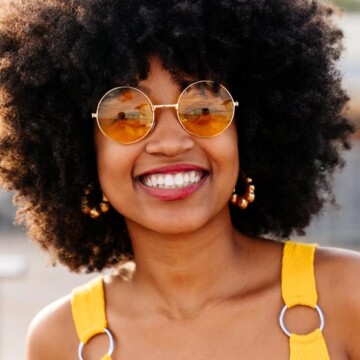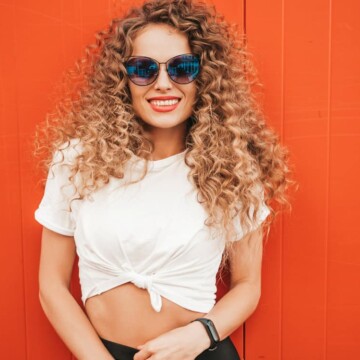
In your efforts to take adequate care of your hair, we're sure you've done some degree of research on the topic. Among the most frequently recommended ways to protect your natural hair is to use satin or silk, but sources rarely tell you which you should use.
For example, should you use a silk or satin pillowcase? Do cotton pillowcases cause hair damage?
If you're wondering whether you should use silk or satin on your hair, this article is for you! In it, we'll highlight the differences between silk and satin and help you choose the right material. Let's settle the debate. We'll start with a comparison of silk vs. satin.
Table of Contents
Comparison Between Satin and Silk
| Features | Silk | Satin |
|---|---|---|
| Material | Natural fabric | Weaving synthetic materials |
| Cost | Expensive | Affordable |
| Snag Probability | Low | High |
| Care | Delicate, hand wash | Machine washable |
| Quality | High | Varies widely |
| Availability | Limited | Widely available |
Both silk and satin are good options for curly hair, as they help reduce frizz and hair breakage while maintaining moisture. Satin is known to be more affordable and widely available, while silk is known to be of higher quality and requires more delicate care.
However, the choice ultimately depends on your personal preference. Some people with curly hair may find that satin works better, while others prefer silk.
What Is Silk?
Silk is a natural protein fiber produced by one of many insects throughout the world. But in most cases, silk comes from silkworm cocoons. The silkworms are domesticated to make it easier to collect the silk.
After it's collected from the cocoons, it goes through extensive processing in factories. One of the most luxurious fabrics known to man, silk is soft and smooth to the touch; it also wicks moisture away from the skin to maximize comfort.
People have used silk for centuries in one capacity or another. But today, it's widely used as a head covering for nighttime protection and modesty in certain religions.

Pros and Cons of Silk for Hair
With the basics of silk out of the way, let's get into some of the pros and cons of the fabric. That way, you'll know if this fabric is the best choice for your hair.
Pros
- Silk is excellent at regulating moisture. It's breathable and won't cause moisture to build up should you sweat at night.
- Silk won't snag your hair. Due to its smoothness, this fabric glides over your hair. This is essential for limiting breakage and dryness as you get your Zs.
- Silk won't dry your hair out. Silk won't trap moisture, so you won't have any problems with dry, frizzy hair by morning if you sleep with a silk pillowcase, bonnet, or scarf.

Cons
- Silk can run a little hot, so if you tend to feel hot at night, silk just might make it a little worse.
- Silk is prohibitively expensive, and many will avoid it for this reason.
For many people, the pros of silk outweigh the cons associated with it, but is that the case for you? You'll have to be the judge.
What Is Satin?
Contrary to popular belief, satin isn't a fabric at all. Satin is technically a weaving type that produces a fabric that's smooth to the touch and glossy in appearance.
Unlike silk, satin fabrics are usually only glossy and smooth on one side. The other side is dull and rougher in texture. For some time, satin fabrics were almost always made of silk, but that's not the case today.
With advances in manufacturing, there are many other material options to choose from, including cotton, rayon, polyester, polyester blends, and more.

Pros and Cons of Satin
As you may have expected, satin comes with both pros and cons. We'll get into them in this section!
Pros
- Satin feels smooth and luxurious, which is good for preserving your hairstyles. It's also soft and supple enough not to irritate the skin.
- Satin is wrinkle-resistant, which is good news for people who wear head wraps as a fashion statement. You won't ever have to iron your satin scarf to make it look presentable.
- Satin is incredibly durable, so you'll have a hard time damaging it. That means you can buy one satin scarf and enjoy it for years to come.
- You can throw your satin scarves in the washing machine without a protective bag.
Cons
- Satin can snag on your strands. While satin is smooth and soft, it can snag your strands, and the chances of that happening increase the more you wash and use the satin.
- The quality of satin-woven fabrics can vary widely. Since satin may be composed of any combination of several fabrics, it can be difficult to determine whether your satin scarf will last or feel the way you expect it to.

Main Differences Between Satin vs. Silk for Hair
Satin and silk may look the same, but they are incredibly different, as we've demonstrated thus far. To give you a clear representation of those differences, we've arranged them in an easy-to-skim list for your convenience.
- What they are at their core: Silk is a fabric, and satin is a type of weaving.
- Cost: Satin is the most affordable of the two. Silk almost always costs several times as much as satin.
- Snag probability: Satin is much more likely to snag your strands than silk is.
- Care: Typical polyester-based satin fabrics can be machine-washed. Silk requires much more thoughtful care. The best way to wash silk products is by hand with cold water and a gentle detergent, but if you want to machine-wash it, you'll need to use a garment bag to protect the fabric. Silk also requires a conditioner or fabric softener to maintain its feel and appearance.
- Quality: It is accepted across the board that silk is of a higher quality than satin, but that's only true if the satin weave isn't made of silk.

Where to Find Silk and Satin Hair Wraps
Whether you've decided to use satin or silk, your next step is to find the scarf and get it home. So, where should you go to find either of them?
Satin is very widely available.
You can find it at your local beauty supply store, big box department stores, and online. You shouldn't have any issues finding satin if that's what you want.
On the other hand, if you want a silk scarf, you may have to narrow your search a bit.
Silk scarves aren't always available at department stores and may not even be available at some beauty supply stores, but if you Google them, you shouldn't have much of an issue getting one delivered.
Note: Some businesses seek to deceive customers by pushing non-silk products under confusing names. They may list products as "satin/silk" or "sateen", which is a cotton blend.
To ensure you're getting real satin, only buy from suppliers/manufacturers that are upfront about what the product is made of. Look for "100% silk" in any product descriptions.

Is Silk or Satin Better for the Hair?
The answer to this question may differ depending on who you ask. Some experts believe silk is better for your hair in every case, while others believe that silk and satin are comparable.
If you're really particular about everything that comes in contact with your hair and have the funds for silk, we say go for silk. If you're a little more flexible and want to save some money, satin may be best.
One thing people don't give enough attention to is whether they should choose a bonnet, scarf, or pillowcase. If the type of silk/satin you use doesn't mesh well with your sleeping style and hair type, you won't reap the benefits of either silk or satin.
Here are a few tips to help you choose:
- If you're a super rough sleeper, we recommend a pillowcase. Scarves and bonnets can come off your head if you sleep wildly.
- If you don't like the idea of sleeping with something on your head, a pillowcase may be best.
- If you have curly hair and regularly wear it big and natural, a bonnet or pillowcase would be a good choice; neither of them will smash your hair as you snooze.
- How to Put Your Curly Hair in a Bonnet
- How to Wrap Hair in Scarf Overnight
- How to Pineapple Hair With Scarf
You may need to experiment with several options to find the best silk (natural fiber) or satin (synthetic fabrics) solution for you. We hope this article has been helpful and enables you to craft a nighttime hair routine that works and encourages beauty sleep!




